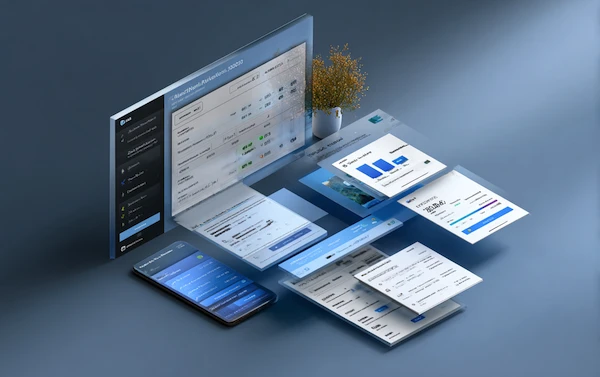Top 5 Accounts Receivable Automation Solutions for 2026

Manual accounts receivable processes are costing your business time, money, and potentially damaging customer relationships. With remote work making traditional collection methods less effective and economic uncertainty putting cash flow under pressure, businesses need automated solutions more than ever.
It's important to distinguish between accounts receivable and accounts payable: accounts receivable refers to money owed to your business, while accounts payable involves money your business owes to suppliers. Automating both accounts receivable and accounts payable processes can further streamline financial operations, reduce errors, and improve overall cash flow management.
Accounts receivable automation solutions use software to streamline invoice creation, payment collection, and cash application—reducing manual tasks by up to 80% while accelerating payment cycles. These tools have evolved from “nice-to-have” efficiency boosters to essential infrastructure for maintaining healthy cash flow and competitive operations.
In this comprehensive guide, you’ll discover the top accounts receivable automation solutions, key features that deliver real ROI, and a step-by-step framework for choosing the right platform for your business needs. Whether you’re handling dozens or thousands of invoices monthly, the right AR automation can transform your finance operations from a cost center into a strategic advantage.
Coming Up
What is Accounts Receivable Automation?
Key Benefits of Accounts Receivable Automation Solutions
Common Challenges and How to Overcome Them
Core Features to Look For in AR Automation Software
How to Choose the Right Accounts Receivable Automation Software
How to Successfully Implement AR Automation
Top Accounts Receivable Automation Tools Compared
Is Accounts Receivable Automation Software Right for You?
What is Accounts Receivable Automation?
Accounts receivable automation refers to using software to digitize and streamline all AR processes—from invoice creation to payment reconciliation. This approach to accounts receivable AR focuses on the management and automation of receivables, helping organizations optimize cash flow and improve financial health.
Instead of relying on spreadsheets, manual data entry, and time-consuming follow-ups, businesses can automate their entire AR process. Automation streamlines the AR process from invoicing to payment reconciliation, reducing manual effort and making collections more efficient for finance teams.
Manual Tasks Replaced by AR Automation:
Traditional manual processes that automation eliminates include:
- Invoice generation: Creating, formatting, and sending invoices individually
- Payment reminders: Manually tracking due dates and sending follow-up emails
- Cash application: Advanced automation can automatically match incoming payments to outstanding invoices, reducing manual effort and errors
- Reporting: Compiling AR aging reports and cash flow forecasts in spreadsheets
- Customer communications: Individual outreach for disputes, payment confirmations, and account updates
The reality is stark: Manual AR processes become exponentially more error-prone as businesses scale. A company processing 50 invoices monthly might manage with spreadsheets, but one handling 500+ invoices faces inevitable mistakes, delayed payments, and countless hours of administrative overhead.
Real-World Example
Consider a B2B SaaS company with 200 recurring customers. Without automation, their finance team spends 15+ hours weekly creating invoices, sending payment reminders, and reconciling payments. With AR automation, this same workflow runs continuously in the background—automatically generating recurring invoices for subscription billing, sending personalized payment reminders based on customer payment history, and instantly applying incoming ACH payments to the correct accounts.
The result? Their AR team (accounts receivable team) shifts from administrative tasks to strategic activities like cash flow forecasting, customer credit analysis, and revenue optimization.
Key Benefits of Accounts Receivable Automation Solutions
An accounts receivable automation solution delivers measurable improvements across every aspect of the cash collection process. Here are the six core benefits driving adoption across businesses of all sizes, including improving cash flow through faster payment collection and automated financial processes:
1. Faster Invoicing & Payments
Automation dramatically reduces your Days Sales Outstanding (DSO)—the time between invoice creation and payment collection. Companies that automate more than half of their accounts receivable processes report a 32% decrease in DSO, equivalent to a reduction of 19 days.
How it works: Automated systems instantly generate and send invoices upon order fulfillment, eliminating the 3-7 day delays common with manual processes. This leads to faster payments, as automated payment reminders and streamlined collection workflows enable businesses to collect payments weeks faster than traditional methods.
2. Reduced Errors & Improved Accuracy
Manual data entry errors plague traditional AR processes, especially for businesses operating across multiple markets or currencies. Automation solutions, such as AR software, can automate data entry and significantly reduce the risk of manual errors. These tools can reduce billing errors by up to 98% while processing transactions 85 times faster than manual systems.
Common errors eliminated: Duplicate invoices, incorrect payment applications, wrong customer addresses, currency conversion mistakes, and calculation errors that lead to customer disputes and delayed payments.
3. Improved Cash Flow Predictability
Real-time AR analytics transform cash flow from guesswork into precise forecasting. Modern platforms provide instant visibility into payment patterns, aging receivables, and collection probabilities. These insights enable businesses to make informed decisions that support a healthier cash flow by reducing delays and optimizing revenue operations.
Key insights available: Which customers consistently pay early vs. late, seasonal payment trends, average collection timelines by customer segment, and predictive models showing likely cash inflows over the next 30-90 days.
4. Better Customer Experience
Self-service payment portals and intelligent communication workflows improve customer satisfaction while accelerating collections. Customers appreciate convenient online payment options and proactive, professional communication.
Customer benefits: 24/7 access to invoices and payment history, multiple payment methods (ACH, credit card, wire transfer), automated payment confirmations, streamlined customer payments through automation for a smoother payment experience, and clear dispute resolution processes. This convenience often leads to faster voluntary payments.
5. Seamless Scalability
Automation handles volume spikes without additional staff. Whether processing 100 or 10,000 invoices monthly, automated systems maintain consistent performance and accuracy.
Scaling advantages: Process unlimited transactions simultaneously, maintain consistent collection workflows regardless of volume, automatically adapt communication timing based on customer behavior, and integrate with existing ERP systems as business complexity grows. Automation also enables efficient AR management, ensuring streamlined processes and optimized cash flow as transaction volumes increase.
6. Enhanced Compliance & Reporting
Automated audit trails and standardized processes simplify regulatory compliance for GAAP, IFRS, and industry-specific requirements. Cloud-based systems ensure secure data storage with anywhere, anytime access for executives.
Compliance benefits: Automatic transaction logging, standardized documentation, real-time financial reporting, secure cloud storage with global access, and comprehensive audit trails that satisfy external accountants and regulatory bodies. AR management software further supports compliance by providing robust audit trails, secure document storage, and features designed to meet regulatory requirements.
Streamlining AR Workflows
Streamlining accounts receivable workflows is essential for businesses aiming to optimize cash flow management and minimize the burden of manual processes. Accounts receivable automation software revolutionizes AR processes by automating repetitive tasks such as generating invoices, sending timely payment reminders, and matching payments to outstanding invoices. By leveraging receivable automation software, finance teams can shift their focus from routine administrative work to more strategic initiatives that drive financial health and customer satisfaction. This transformation not only accelerates the accounts receivable cycle but also ensures greater accuracy and consistency across all AR processes, ultimately supporting a healthier bottom line.
How Automation Transforms AR Processes
Automation brings a new level of efficiency, accuracy, and speed to accounts receivable operations. Automated accounts receivable systems are designed to handle large volumes of invoices and payments with minimal human intervention, significantly reducing the risk of errors and delays. By ensuring that transactions are processed promptly and correctly, businesses can maintain steady cash flows and foster stronger customer relationships through a seamless payment experience. Automated reminders and follow-ups play a crucial role in minimizing late payments, helping organizations maintain healthier cash flows and reducing the administrative burden on AR teams. The result is a more reliable, scalable, and customer-friendly accounts receivable process.
Key Workflow Improvements
Implementing automated accounts receivable software leads to several key improvements in AR workflows. One of the most significant benefits is the reduction in days sales outstanding (DSO), as automation accelerates payment cycles and improves the accuracy of payment matching. Real-time insights into cash flows and payment trends empower finance teams to practice proactive credit management and make more informed financial decisions. Integration with existing accounting systems eliminates the need for manual data entry, reducing errors and boosting productivity. By streamlining AR workflows with receivable software, businesses can accelerate payments, decrease the risk of bad debt, and strengthen customer relationships—all while gaining greater visibility and control over their financial operations.
Common Challenges and How to Overcome Them
While accounts receivable automation delivers significant benefits, implementation isn’t without potential obstacles. Many businesses encounter common challenges when managing accounts receivable manually, such as inefficiencies and limited visibility. Here are the four main challenges and practical solutions:
1. Software Compatibility Issues
The Challenge: Legacy accounting systems may not integrate easily with modern AR platforms, creating data silos and workflow disruptions.
The Solution: Choose tools with robust integrations for platforms like QuickBooks, NetSuite, or Xero, and ensure they support leading accounting software to guarantee seamless data flow. Leading solutions offer 50+ native integrations and API flexibility. Request a technical assessment during vendor evaluation.
2. Change Management and Employee Resistance
The Challenge: Finance teams may resist automation due to concerns about job security or learning new systems.
The Solution: Implement phased rollouts, provide comprehensive training, and emphasize how automation eliminates tedious tasks to enable more strategic work.
3. Cost Concerns and ROI Uncertainty
The Challenge: Significant upfront investment with unclear ROI, especially with per-user pricing that scales expensively.
The Solution: Calculate total cost of ownership including current manual processing costs. Most businesses see payback within 6-12 months through reduced DSO and labor savings. Choosing the right accounts receivable software is crucial to maximize ROI and minimize costs, as it ensures automation, seamless integration, and improved collections.
4. Data Migration Complexity
The Challenge: Moving historical invoices and customer data from legacy systems can be time-consuming and error-prone.
The Solution: Choose vendors offering dedicated migration support and white-glove data services. Plan migration during low-activity periods and maintain parallel systems during transition.
Core Features to Look For in AR Automation Software
Not all accounts receivable automation solutions are created equal. When evaluating platforms, prioritize these eight essential features that separate basic billing tools from comprehensive AR automation systems:
1. Automated Invoicing
Must-have capabilities: Auto-generation from sales data, customizable templates, recurring invoices with automatic scheduling and customization options, and multi-format delivery (email, PDF, EDI). Advanced solutions automatically pull customer and product information from your ERP to eliminate manual data entry.
2. Payment Reminders & Notifications
Look for: Customizable reminder workflows based on invoice age, customer payment history, and risk profiles. The best platforms send personalized messages at optimal intervals and automatically escalate overdue accounts through different communication channels. Automated reminders play a crucial role in supporting timely payments and reducing overdue accounts by prompting customers to pay on schedule.
3. Cash Application Automation
Critical functionality: Auto-matching incoming payments to outstanding invoices, even with partial payments or multiple invoice settlements. Advanced systems handle bank feeds, lockbox processing, and exception management for unmatched transactions.
4. Customer Portals
Essential features: Self-service invoice viewing, payment processing, dispute submission, and payment history access. Modern portals support multiple payment methods (ACH, credit card, wire transfer) and mobile-responsive design for on-the-go access. By centralizing these capabilities, customer portals streamline the payment process for both customers and businesses, making transactions faster and more efficient.
5. Analytics & Reporting
Key reports: Real-time DSO tracking, aging reports, analytics that track the collections process to help improve collection efficiency, collection efficiency metrics, cash flow forecasting, and customer payment pattern analysis. Look for customizable dashboards and automated report scheduling.
6. Integrations
Priority connections: Native integrations with your accounting software (QuickBooks, NetSuite, Sage), CRM systems, payment processors, and banking platforms. API availability for custom integrations as your business evolves.
7. Compliance Tools
Required capabilities: Automated audit trails, tax calculation and reporting, SOX compliance support, and secure document storage. International businesses need multi-jurisdiction tax handling and regulatory reporting.
8. Multi-Currency Support
For global operations: Automatic currency conversion, multi-currency invoicing, hedge accounting capabilities, and region-specific payment methods. Essential for businesses with international customers or subsidiaries.
Evaluation Tip: Create a feature matrix comparing your top 3-5 vendor options against these criteria. Weight each feature based on your business priorities to make an objective selection decision.
How to Choose the Right Accounts Receivable Automation Software
Selecting the right accounts receivable automation software is a critical step in optimizing AR processes and enhancing overall financial efficiency. The ideal receivable automation software should seamlessly integrate with your existing accounting systems, automate manual AR tasks, and provide real-time visibility into cash flows and payment trends.
When evaluating options, it’s important to consider how well the software can adapt to your current AR processes and support your business as it grows. By choosing a solution that aligns with your operational needs and financial goals, you can streamline accounts receivable workflows, improve cash flow management, and set your organization up for long-term success.
Key Selection Criteria
When choosing AR automation software, keep these essential criteria in mind:
- Integration Capabilities: Ensure the software integrates smoothly with your existing accounting systems to maintain consistent data flow and eliminate manual data entry.
- Automation Features: Look for comprehensive automation of manual AR tasks, including invoice generation, payment reminders, and cash application, to maximize efficiency.
- Real-Time Insights: Opt for solutions that offer real-time analytics and reporting on key AR metrics such as DSO, payment trends, and customer payment history, enabling better cash flow management.
- Scalability: Select software that can scale with your business, handling increased invoice and payment volumes without sacrificing performance.
- Security and Compliance: Prioritize platforms that safeguard financial data and comply with industry regulations, protecting your business from data breaches and financial risks.
- Customer Support: Choose a provider that offers robust customer support, including training and ongoing assistance, to ensure a smooth implementation and continued success.
By focusing on these criteria, businesses can confidently select an AR automation solution that streamlines accounts receivable processes, accelerates payments, and supports improved financial health.
How to Successfully Implement AR Automation
Successful AR automation implementation requires careful planning and methodical execution. A key goal of AR automation is to optimize the payment collection process, making it more efficient and less manual. Follow this 8-step roadmap to ensure smooth deployment and rapid ROI:
1. Assess Current AR Processes
Map current invoicing timelines, payment collection methods, and manual touchpoints. Identify bottlenecks like delayed invoice creation, inconsistent follow-ups, or manual payment matching. This baseline helps measure automation impact.
2. Select the Right Solution
Prioritize solutions with strong integrations for your tech stack, scalable pricing models, and responsive customer support. When evaluating options, look for the best accounts receivable software by considering key features such as scalability, automation, integration capabilities, insightful reporting, and security standards. Request demos focusing on your specific use cases and verify references from similar-sized businesses in your industry.
3. Prepare Data for Migration
Standardize customer contact information, resolve duplicate accounts, and organize historical invoice data. Archive or purge outdated records. Clean data ensures accurate automation and prevents errors in the new system.
4. Set Up System Integrations
Establish data flows between your ERP/accounting software, CRM, payment processors, and banking platforms. Test integrations thoroughly with sample transactions before going live to prevent disruptions.
5. Configure Automated Workflows
Set up invoice generation triggers, customize payment reminder sequences, establish approval workflows for credits/adjustments, and define escalation paths for overdue invoices, including automated follow-up processes to ensure timely collection. Start conservative and optimize based on results.
6. Train Your Team
Provide hands-on training for all users, create quick-reference guides for common tasks, and designate power users as internal support resources. Schedule follow-up training sessions 30 days post-launch.
7. Communicate With Customers
Notify customers 2-4 weeks before launch about new invoicing formats, payment portal access, and updated contact information. Provide clear instructions for new payment methods and emphasize benefits like 24/7 invoice access. Effective communication workflows also help reduce overdue payments by keeping customers informed and engaged with timely reminders.
8. Monitor & Optimize Performance
Monitor DSO changes, payment timeline improvements, error reduction rates, and customer satisfaction scores. Use these insights to refine workflows and maximize automation benefits over time. Streamlining accounts receivable processes is essential for continuous improvement, as it reduces manual work, accelerates collections, and enhances overall financial performance.
Implementation Timeline: Most businesses complete steps 1-7 within 4-8 weeks, with full optimization achieved within 3-6 months of go-live.
Top Accounts Receivable Automation Tools Compared
The AR automation market offers solutions ranging from simple invoicing tools to comprehensive enterprise platforms. Here are five leading solutions, each with distinct strengths for different business needs:
1. Solvexia
Best for: Mid-market companies seeking comprehensive automation with strong analytics capabilities.
Key strengths: Advanced reporting and dashboard customization, broad integration compatibility, and user-friendly interface requiring minimal IT support. Offers powerful analytics that help CFOs identify profit optimization opportunities. Installation typically completed within hours rather than weeks.
2. NetSuite AR
Best for: Growing businesses already using NetSuite ERP or those needing tight accounting integration.
Key strengths: Native ERP integration eliminates data silos, robust multi-currency support, and scalable architecture. Strong compliance features and real-time financial reporting. Ideal for businesses with complex accounting requirements and international operations.
3. Stripe Invoicing
Best for: Tech-savvy businesses prioritizing global payment processing and developer-friendly features.
Key strengths: 135+ currency support, 25+ language localization, and seamless integration with Stripe's payment ecosystem. Mobile-responsive invoicing with most payments settled within three days. Strong API for custom integrations and automated workflows.
4. Upflow
Best for: B2B companies focused on collaborative collections and customer relationship management.
Key strengths: Real-time AR analytics with predictive insights, collaborative workflows between sales and finance teams, and comprehensive payment options including ACH and wire transfers. Specializes in reducing DSO through intelligent automation and team coordination.
5. Corcentric
Best for: Large enterprises seeking managed AR services with guaranteed DSO reduction.
Key strengths: Combines software automation with managed services expertise, guaranteed fixed DSO improvements, and handles high-volume invoice processing ($245B annually). Offers both EIPP and full managed AR solutions with dedicated support teams.
Selection Guide: Consider your primary needs—simple invoicing (Stripe), comprehensive ERP integration (NetSuite), collaborative collections (Upflow), enterprise management (Corcentric), or analytics-focused automation (Solvexia)—to narrow your evaluation focus.
Is Accounts Receivable Automation Software Right for You?
If you’re a CFO and you are looking to make your accounts receivable management more efficient while also increasing revenue, accounts receivable automation solutions are the solution you are looking for.
As is the case with all corporate decisions, choosing to automate, and choosing the software is something that must be done with consideration for all the moving parts involved.
However, once you decide to automate, your choice in software will go a long way towards determining whether automating was a good decision. You must choose an automation solution that is user friendly, cost effective and flexible enough to grow with your company.
Solvexia checks all those boxes. If you’d like to learn how Solvexia’s automation can accelerate your accounts receivables management, book a free demo today.
FAQ
What are the 5 C’s of accounts receivable management?
The 5 C’s are key factors businesses use to evaluate credit risk when extending payment terms:
- Character: The borrower’s reputation and reliability.
- Capacity: Their ability to repay the debt.
- Capital: The borrower’s financial resources.
- Conditions: External factors like the economy or industry trends.
- Collateral: Assets pledged to secure the debt.
What is the 10 rule for accounts receivable?
The “10 rule” is an informal guideline suggesting that no more than 10% of your total receivables should be over 30 days past due. Staying below this threshold helps maintain healthy cash flow and minimize bad debt risk.
Intelligent reconciliation solution
Intelligent rebate management solution
Intelligent financial automation solution
Intelligent Financial Automation Solution
Intelligent financial automation solution
Intelligent financial automation solution
Intelligent financial automation solution
Intelligent financial automation solution
Intelligent regulatory reporting solution
Free up time and reduce errors
Recommended for you

Request a Demo
Book a 30-minute call to see how our intelligent software can give you more insights and control over your data and reporting.

Reconciliation Data Sheet
Download our data sheet to learn how to automate your reconciliations for increased accuracy, speed and control.

Regulatory Reporting Data Sheet
Download our data sheet to learn how you can prepare, validate and submit regulatory returns 10x faster with automation.

Financial Automation Data Sheet
Download our data sheet to learn how you can run your processes up to 100x faster and with 98% fewer errors.

Financial Automation Data Sheet
Download our data sheet to learn how you can run your processes up to 100x faster and with 98% fewer errors.

Financial Automation Data Sheet
Download our data sheet to learn how you can run your processes up to 100x faster and with 98% fewer errors.

Financial Automation Data Sheet
Download our data sheet to learn how you can run your processes up to 100x faster and with 98% fewer errors.

Financial Automation Data Sheet
Download our data sheet to learn how you can run your processes up to 100x faster and with 98% fewer errors.

Financial Automation Data Sheet
Download our data sheet to learn how you can run your processes up to 100x faster and with 98% fewer errors.

Rebate Management Data Sheet
Download our data sheet to learn how you can manage complex vendor and customer rebates and commission reporting at scale.

Top 10 Automation Challenges for CFOs
Learn how you can avoid and overcome the biggest challenges facing CFOs who want to automate.
.svg)



